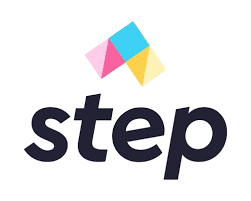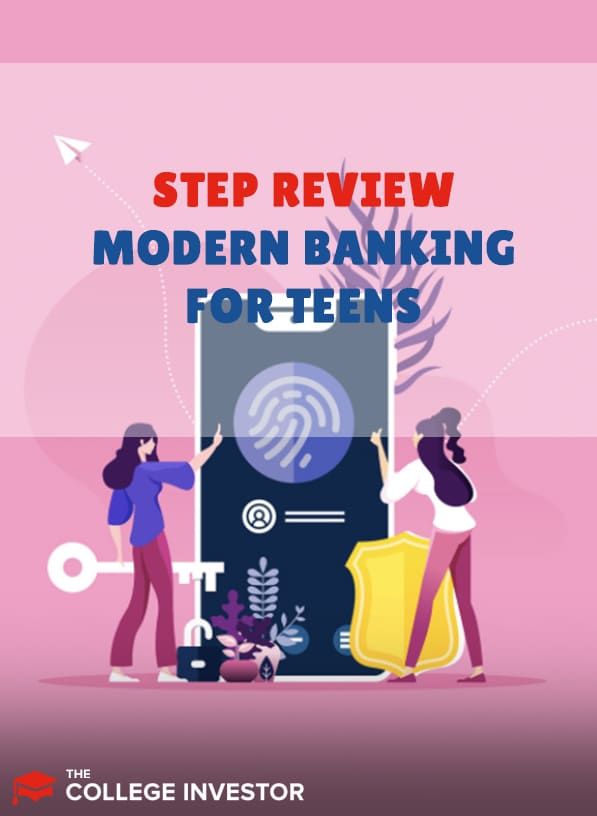
Teaching teens about money and sound financial management eventually comes down to them using real money.
There’s a fine line to walk for parents because you don’t want to give your teen too much money so that they become irresponsible. On the other hand, you want to give them enough that they have something feasible to manage and are able to set goals.
Step is a fintech app that is meant to help teens transition into real money management. It allows parents to view spending activity on their teen’s app (via the parent account) and even send money to their teen. While Step isn’t a full-blown checking account, it does have many checking account features. In this article, we’ll run through what they are and who Step is most likely for.
Quick Summary
- Fee-free teen banking
- Creating an account requires an adult sponsor
- Using the Step debit card builds credit history
Step Details | |
|---|---|
Product Name | Step |
Min Deposit | $0 |
Monthly Fee | $0 |
Earns Interest | Yes |
Account Types | Checking |
Promotions | $3 referral credits |
Who Is Step?
Step is a financial app with a debit card that is oriented towards teens. The company is based in Palo Alto, CA. It was founded in 2018 by CJ MacDonald and Alexey Kalinichenko. Step is technically a fintech rather than a bank. However, banking services are provided through its partner-bank Evolve Bank & Trust.
“Our mission is to educate the next generation to be smarter with money. And it’s always bugged me that schools don’t teach kids about money. Families, rich or poor, don’t talk about money. You really have to have an understanding of the financial ecosystem just to get by in life.” said MacDonald in an interview with TearSheet.
Step has been showcased by teen stars such as Charlie D'Amelio on TikTok.
⚠︎ This Is A Banking Service Provider, Not A Bank.
Step is a financial technology company, not a bank. While it uses partner banks to provide banking services, your FDIC-insurance protection may be limited. Read this article from the FDIC to understand the risks of using a non-bank company.
What Do They Offer?
Step provides a “lite” version of a checking account for teens. You have to be 18 or older in the U.S. to open a checking account without a guardian. Those under 18 years of age can open a checking account with a guardian (i.e., joint checking), but there may be restrictions, depending on the bank they go with.
The Step Card processes like a credit card. But unlike a credit card, money is withdrawn directly from your Step account for each transaction. This means that teens can begin building credit with the Step Card without ever having to worry about missing payments or paying interest.
Step Features
Some notable features of Step include:
The Step Card is your debit card. It's a physical card. Once you open an account and request your card it takes 7-10 days to receive it. To use your step account until your card arrives, you can link it to Apple Pay or Google Pay.
Step Card Features
When you sign up with Step, you can choose from two secured credit cards: The Step Visa Card, which is free, and the Step Black Visa Signature Card, which has a $99 annual fee. Here's a close look at the features each card offers:
Step Visa Card
The Step Visa card is a free secured credit card that not only helps you build your credit score, but also comes with up to 3% cash back on purchases, and eligible direct deposit. At the time of this writing, you can earn up to 5.00% on your Step savings balance.
Key Features:
- Free
- Get paid up to 2 days early with eligible direct deposit of $500/month
- Earn 3% cash back at top brands
- Earn 2% cash back on dining and delivery
- Earn 2% cash back on charitable donations
- Earn 1% cash back on entertainment
- Earn 1% cash back on gaming
- Deposits are insured by FDIC up to $250,000 through Steps partnership with Evolve Bank & Trust.
Step Black Visa Signature Card
If you're willing to spend $99 yearly for enhanced Step benefits, consider signing up for the Step Black Visa Signature Card. This is a metal secured credit card, with enhanced security features. Here are the benefits that come with this card:
Key Features:
- $99 annual fee
- Over $500 in annual perks
- Get paid up to 2 days early with direct deposit
- Earn 8X points on up to $6000 of annual purchases with select Step Black retail partners
- Earn 3% cash back on dining
- Earn 2% cash back on charities
- Earn 2% cash back on entertainment
- Earn 1% cash back on everything else
- Access to Visa Signature benefits
- Up to $1,000,000 in FDIC insurance coverage through Evolve Bank & Trust
Withdrawals And Deposits
Step provides debit card functionality for teens but other checking features are not present. For example, the only way to move money into your Step account is from another bank account via a debit card or by linking to a Cash App, Venmo, or PayPal account. Linking a debit card provides immediate money transfers. Going through CashApp, Venmo, or PayPal will take 1-3 business days.
There is no mobile check deposit or cash deposit. Paper checks don’t come with the account either. You can, however, easily make direct deposits from an employer. Just give the employer your account and routing numbers, which are the same for a regular checking account.
Withdrawing money is similar — you have to move money into another checking account. To date, cash withdrawals are not available either, but may be in the future according to Step.
How Does Step Make Money?
Step doesn’t make money by charging customers fees. Instead, it gets a percentage of debit card interchange fees that are charged to merchants for each transaction. Interchange fees are debit/credit card network fees.
Are There Any Fees?
No, Step does not charge any fees whatsoever. In addition to no monthly fees, you'll never pay overdraft or service fees either.
Header |  |  |  |
|---|---|---|---|
Product Name | Step Banking For Teens | Axos First Checking | Chase High School Checking |
Rating | |||
Monthly Fees | $0 | $0 | $0 |
Earns Interest | |||
Min Deposit | $0 | $50 | $0 |
ATM Access | 30,000+ Free ATMs | 91,000+ Free ATMs | 16,000+ Free ATMs |
Builds Credit | |||
Cell |
How Do I Open An Account?
You can visit the Step website and click the "Get Started" button to create an account. Anyone age 13 or above is eligible to join Step. However, every account will also need an adult sponsor (parent or guardian).
Is My Money Safe?
Yes - through its bank partner (Evolve Bank & Trust), Step insures deposits up to $250,000 per depositor through FDIC insurance. Step Black members can be eligible for up to $1,000,000 of FDIC coverage.
Is It Worth It?
For those that don’t have a bank offering teen checking, Step can be worth it. While it doesn’t have all the features that checking accounts offered by banks have, it has enough to meet most teens’ needs. Plus, its one of the only banking services that can help teens build credit without taking on the risk of credit card use.
If you want to compare similar banking services for teens, check out our checking accounts for kids review and best prepaid cards for teens. Some notable mentions are Axos First Checking and the FamZoo prepaid debit card.
Step Features
Account Types | Checking |
Minimum Deposit | $0 |
Earns Interest | Yes |
Maintenance Fee | $0 |
Overdraft Fee | $0 |
Service Fees | $0 |
Branches | None |
ATM Availability | 30,000+ free ATMs nationwide |
Customer Service Number | None |
Customer Service Email | hello@step.com |
Mobile App Availability | iOS and Android |
Direct Deposit | Yes |
Bill Pay | No |
FDIC Certificate | 1299 |
Promotions | Referral credits up to $5 |
Step Review
-
Pricing and Fees
-
Ease of Use
-
Customer Service
-
Features and Options
Overall
Summary
Step is a teen banking app and debit card that charges no fees and can help teens begin to build a positive credit history.
Pros
- Completely fee-free banking
- Debit card that builds credit
- No minimum deposit requirement
Cons
- No interest earned on deposits
- No customer service number
- No branch or ATM access

Robert Farrington is America’s Millennial Money Expert® and America’s Student Loan Debt Expert™, and the founder of The College Investor, a personal finance site dedicated to helping millennials escape student loan debt to start investing and building wealth for the future. You can learn more about him on the About Page or on his personal site RobertFarrington.com.
He regularly writes about investing, student loan debt, and general personal finance topics geared toward anyone wanting to earn more, get out of debt, and start building wealth for the future.
He has been quoted in major publications, including the New York Times, Wall Street Journal, Washington Post, ABC, NBC, Today, and more. He is also a regular contributor to Forbes.
Editor: Clint Proctor Reviewed by: Claire Tak
